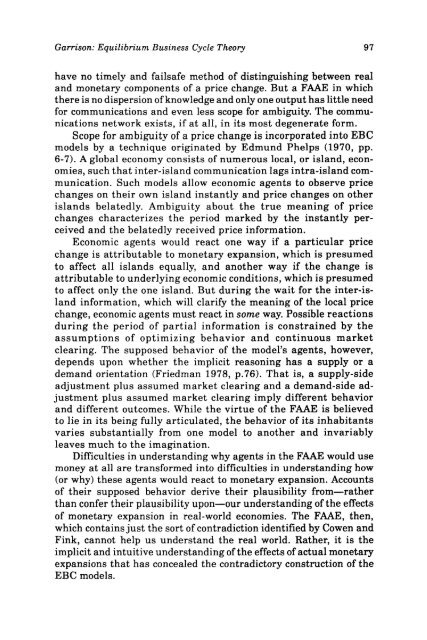Review of Austrian Economics - The Ludwig von Mises Institute
Review of Austrian Economics - The Ludwig von Mises Institute
Review of Austrian Economics - The Ludwig von Mises Institute
You also want an ePaper? Increase the reach of your titles
YUMPU automatically turns print PDFs into web optimized ePapers that Google loves.
Garrison: Equilibrium Business Cycle <strong>The</strong>ory 97<br />
have no timely and failsafe method <strong>of</strong> distinguishing between real<br />
and monetary components <strong>of</strong> a price change. But a FAAE in which<br />
there is no dispersion <strong>of</strong> knowledge and only one output has little need<br />
for communications and even less scope for ambiguity. <strong>The</strong> communications<br />
network exists, if at all, in its most degenerate form.<br />
Scope for ambiguity <strong>of</strong> a price change is incorporated into EBC<br />
models by a technique originated by Edmund Phelps (1970, pp.<br />
6-7). A global economy consists <strong>of</strong> numerous local, or island, economies,<br />
such that inter-island communication lags intra-island communication.<br />
Such models allow economic agents to observe price<br />
changes on their own island instantly and price changes on other<br />
islands belatedly. Ambiguity about the true meaning <strong>of</strong> price<br />
changes characterizes the period marked by the instantly perceived<br />
and the belatedly received price information.<br />
Economic agents would react one way if a particular price<br />
change is attributable to monetary expansion, which is presumed<br />
to affect all islands equally, and another way if the change is<br />
attributable to underlying economic conditions, which is presumed<br />
to affect only the one island. But during the wait for the inter-island<br />
information, which will clarify the meaning <strong>of</strong> the local price<br />
change, economic agents must react in some way. Possible reactions<br />
during the period <strong>of</strong> partial information is constrained by the<br />
assumptions <strong>of</strong> optimizing behavior and continuous market<br />
clearing. <strong>The</strong> supposed behavior <strong>of</strong> the model's agents, however,<br />
depends upon whether the implicit reasoning has a supply or a<br />
demand orientation (Friedman 1978, p.76). That is, a supply-side<br />
adjustment plus assumed market clearing and a demand-side adjustment<br />
plus assumed market clearing imply different behavior<br />
and different outcomes. While the virtue <strong>of</strong> the FAAE is believed<br />
to lie in its being fully articulated, the behavior <strong>of</strong> its inhabitants<br />
varies substantially from one model to another and invariably<br />
leaves much to the imagination.<br />
Difficulties in understanding why agents in the FAAE would use<br />
money at all are transformed into difficulties in understanding how<br />
(or why) these agents would react to monetary expansion. Accounts<br />
<strong>of</strong> their supposed behavior derive their plausibility from—rather<br />
than confer their plausibility upon—our understanding <strong>of</strong> the effects<br />
<strong>of</strong> monetary expansion in real-world economies. <strong>The</strong> FAAE, then,<br />
which contains just the sort <strong>of</strong> contradiction identified by Cowen and<br />
Fink, cannot help us understand the real world. Rather, it is the<br />
implicit and intuitive understanding <strong>of</strong> the effects <strong>of</strong> actual monetary<br />
expansions that has concealed the contradictory construction <strong>of</strong> the<br />
EBC models.

















